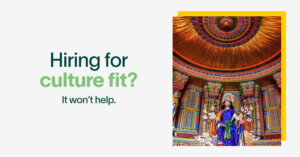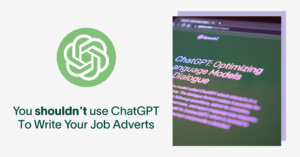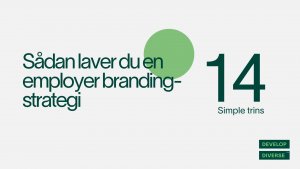It’s often said that building a diverse, inclusive, and equitable organisation is an ongoing journey, not a finite process. And while continuous improvement is key to increasing your organisation’s overall sense of belonging, it’s hard to know where to start on implementing positive changes without first knowing where you’re starting from.
If you set big goals before you’re ready, it’s likely to feel overwhelming. Meanwhile, if you’ve reached a good level of maturity but are struggling with what to do next, your progress can stall.
Understanding your organisation’s level of DEI maturity is critical to creating a strategy that fosters continuous progress, and helps you set the right goals at the right times that are tailored to your organisation’s unique setup.
Here’s why.
Understanding the DEIB maturity model
The DEI Maturity model primarily consists of 5 stages or 5 levels. These are: being aware, being compliant, being tactical, being integrated, being sustainable.
“There’s a really distinct difference between organisations that are right at the beginning of their DEI journey versus those that have fully embedded it into the fabric of their organisation,” explains Erica D’Eramo, founder and CEO of DEI consultancy Two Piers Consulting.
“When organisations are just starting their DEI journey, this may come from external pressure, like shareholders or marketplace reputation. It’s usually driven by lagging indicators, like metrics on workforce composition. Usually in the earlier stages, organisations don’t yet have the infrastructure, resources, or DEI team in place.”
Alex HL Taylor, DEIB researcher and intersectionality specialist at the University of Sussex, UK, agrees — adding that moving towards DEI maturity is about seeing more of the nuance in what you’re trying to achieve.
“When you become more mature in your DEI efforts, it means you understand the nuance of how it impacts your company, and needs to be fully integrated with your whole organisation,” she explains.
“It’s moving beyond that one-dimensional effort, like increasing the diversity of your recruitment pipeline, and viewing the micro level — like individual relational aspects, subjective experiences, and your leadership. It becomes embedded throughout your organisation’s different functions and goals. It spirals out beyond your organisation too, and the biases embedded within the societal context in which you’re operating. It means you’re constantly pushing back against these forces with the work you’re doing.”
DEI maturity typically exists on a spectrum, but can be broken down into 5 stages and milestones based on the DEI Maturity Model.
Level 1 - Being Aware
The first step towards becoming more diverse and inclusive is often triggered by a wake-up call, like bad PR or a leader realizing things aren’t equal.
This “Aware” stage is about self-reflection: why are we doing this, and what’s our goal?
Companies often try to do too much too soon, we recommend focusing on a specific, achievable goal that aligns with their current state. For example, a company that we worked with realized they needed to do more for their minority employees, even though their mission was to help underserved communities. They had a difficult conversation, defined what “diversity, equity, and inclusion” meant for them, and started working from there.
At this stage, organisations should focus on a few key considerations:
- Why does DEI matter to us?
- What is our vision for DEI at our organisation?
- What does our current workforce and organisational setup look like?
Level 2 - Being Complaint
The “Compliant” stage is about following the rules set by law or lawsuits. While this is a good first step, it shouldn’t be the end goal. Many companies get stuck here, just meeting the minimum requirements without making deeper changes.
We recommend our clients going beyond compliance by setting even higher goals and connecting DEI efforts to the company’s overall mission and goals.
Key considerations at this stage include:
- How can we connect DEI to our strategic and department-level goals?
- What tooling/data do we need to achieve this?
- What processes do we need to change to advance our goals?
- How can we scale accountability for DEI across the organisation?
Level 3 - Being Tactical
Companies in the “Tactical” stage are actively working on their own DEI initiatives, often driven by employee-led groups. This can be successful, but it can also lead to uneven progress across the company.
We recommend creating a clear DEI strategy, identifying areas for standardization, and connecting efforts across all levels of the organization.
For example one of our clients – they have many employee-led groups working on DEI, and company leaders meet with them regularly to ensure they have the resources and influence they need. They have also standardized some processes, like interview questions, and expanded their efforts to their broader community.
Level 4 - Being Integrated
The “Integrated” stage of DEI maturity is when a company has a clearly defined strategy, an inclusive culture, and considers the impact of their actions on all stakeholders. They are humble and constantly looking for ways to improve, even if they have successful programs in place.
We emphasize that companies need to create systems and structures to ensure lasting progress, not just rely on individual leaders or trends. They should also be willing to challenge the status quo and find creative solutions.
At this stage, organisations need to keep evaluating their strategy and making sure things stay effective over the long-term:
- Are we regularly assessing our external processes in terms of their DEI impact, such as our supply chains, customers, shareholders, and other relationships?
- Is our strategy still effective? What needs to change?
- How can we increase our external influence and create change in our community or chosen causes?
Level 5 - Being Sustainable
The “sustainable” stage is the most advanced level of diversity, equity, and inclusion (DEI) efforts within an organization. Here’s what it entails:
Deeply ingrained: DEI becomes a core part of the company culture, like its DNA.
Resilient: DEI efforts can withstand challenges like economic downturns or leadership changes.
Continuous improvement: Leaders strive for ongoing progress and refinement of DEI initiatives.
Example: Imagine a company where everyone feels welcome and respected, and fairness is like second nature. This is what a “sustainable” DEI stage looks like.
5 tips to assess and advance your organisation’s DEI maturity
1. Get really clear on your ‘why’.
By this point, most organisations know that DEI is the right thing to do. But when defining strategy and evaluating your level of DEI maturity, it’s not enough. Erica says organisations need to get very specific on what they want to achieve.
“When people say that they’re doing DEI because it’s the right thing to do, it’s a red flag — donating all your proceeds to charity would also be the ‘right’ thing to do, but it doesn’t make good business sense,” she says. “As a business, you need to go beyond that reason and approach your ‘why’ from a strategic perspective. You need to understand how it relates to your business function and overarching strategic goals.
“And that can feel a bit icky,” Erica concedes. “It can feel transactional to say there’s a business objective to DEI. But it needs to be both to work — it’s both the right thing to do and it’s good for your business.”
Erica’s tip: Create a safe environment for conversations
A lot of the time, Erica says, shame and fear can get in the way of honest answers on your ‘why’. Focus on creating a safe, judgement-free environment when discussing your why. Think about what you’d like the organisation to look and feel like when the work is done, and key things you want to change.
For example, if you want to increase your diversity representation, think about what that actually means, and why.
2. Start with inclusion, not diversity.
When most organisations start their DEI journey, they make a logical assumption that their first step should be to bring more people from different identity groups in. But this juncture, says Alex, is where organisations need to pause and reframe their perspective.
“When you’re in the earliest stages of your DEI journey, it’s important to know what’s happening in your organisation right now and developing from there,” she says. “So understanding your workforce composition and basic DEI data will help you build a picture of where you are currently.
“But from there, the worst thing would be to start putting all of your resources into recruitment based on this data alone. Diversity can’t exist without inclusion, so organisations need to focus on fostering inclusivity first before they start increasing their diversity hiring efforts. Otherwise, they risk wasting resources and burning out without contributing to progress.”
Alex’s tip: Invest in external help to establish a direction of travel
When you know you have a few representation issues, working with an external DEI consultant can help you get a firmer grip on the next best actions you can take beyond immediately switching up your recruitment strategy.
3. Look for root causes of discrimination and bias, not symptoms.
As organisations get more comfortable measuring their DEI data, one key hallmark of a maturing strategy is how they dig below the surface to identify the real issues at their core.
“Most organisations start out their DEI efforts with a number, like their workforce representation,” explains Erica. “Advancing beyond this initial stage means that you don’t just see the number, you start becoming curious about what it’s telling you. Instead of using data like your workforce composition as an action point, you start to recognise that it’s a symptom of a greater problem upstream, and your goal becomes more about finding out why.”
4. Start getting comfortable with discomfort.
Once organisations are approaching the midpoint of their DEI maturity, they must encourage more dialogue and conversation on DEI — from everyone.
“To push beyond the checkbox stage of DEI, organisations need to get more comfortable with being uncomfortable,” Alex says. “The core reason we even have DEI is because of the relational element — how people interact with other people. At this stage, organisations need to focus on cultivating conversation on DEI, and making sure employee voices and perspectives are heard. Investing in employee surveys and roundtables can help organisations collect upward and downward input.”
But as Alex cautions, organisations need to be careful about leaning too heavily on their marginalised employees to drive this stage of their DEI strategy forward. To employees, this may feel tokenistic, and create an added extra burden.
“This needs to be done very carefully,” she advises. “Research is showing us that belonging is actually a lot more nuanced than how companies typically focus on it right now. There is already so much pressure on marginalised employees and the concept of belonging that organisations should avoid handing this extra burden down to them as well.”
5. Build accountability across the organisation with goals and objectives.
DEI can’t work if it exists in a silo. As part of your ongoing conversation on DEI, you’ll also need to start scaling accountability to bring the whole organisation with you. Erica says this starts at a business unit level.
“Accountability is key for advancing your level of DEI maturity. If we think about safety for example, we’d never say it’s solely owned by the safety department. It’s the same principle with DEI — you need to engage the actual people on the ground to build out individual objectives and key results so they can play their part. This should be led from the top-down, but not dictated — people need to feel like they’re a part of the solution.
“Each leader and each manager needs to understand how it fits into their goals, what their gaps are in terms of current DEI performance, and how diversity, equity, and inclusion translate at the individual business level,” Erica adds. “Organisations also need to focus on providing each with the training and knowledge to make this work.”
Erica’s tip: Help business units identify and measure leading indicators.
For each business unit to play their part and set goals, they need data. Erica suggests giving business units or teams access to platforms that help them track and monitor their leading DEI indicators — including employee pulse survey results, retention, compensation, and performance processes. Each business unit should also collect qualitative feedback on what’s working — and what’s not.
___
Whether your organisation is in the first stages of its DEI strategy or reaching maturity, Develop Diverse is the perfect partner to help you scale your DEI efforts. Trusted by organisations including Vestas, Danske Bank, and Maersk Tankers, Develop Diverse combines AI and peer reviewed research to help you scale your inclusion and belonging efforts, long-term. Book a demo with one of our team members today.





